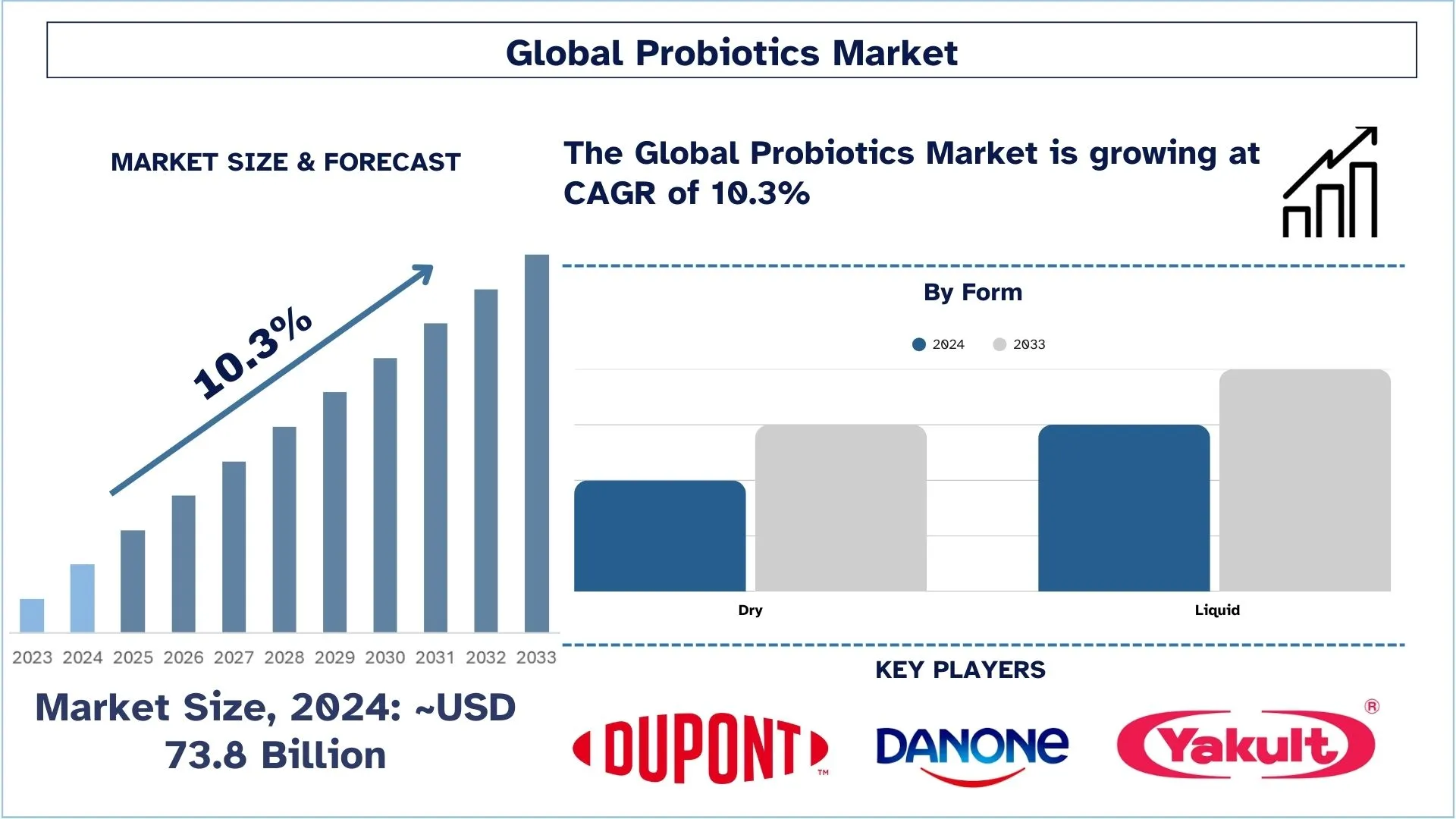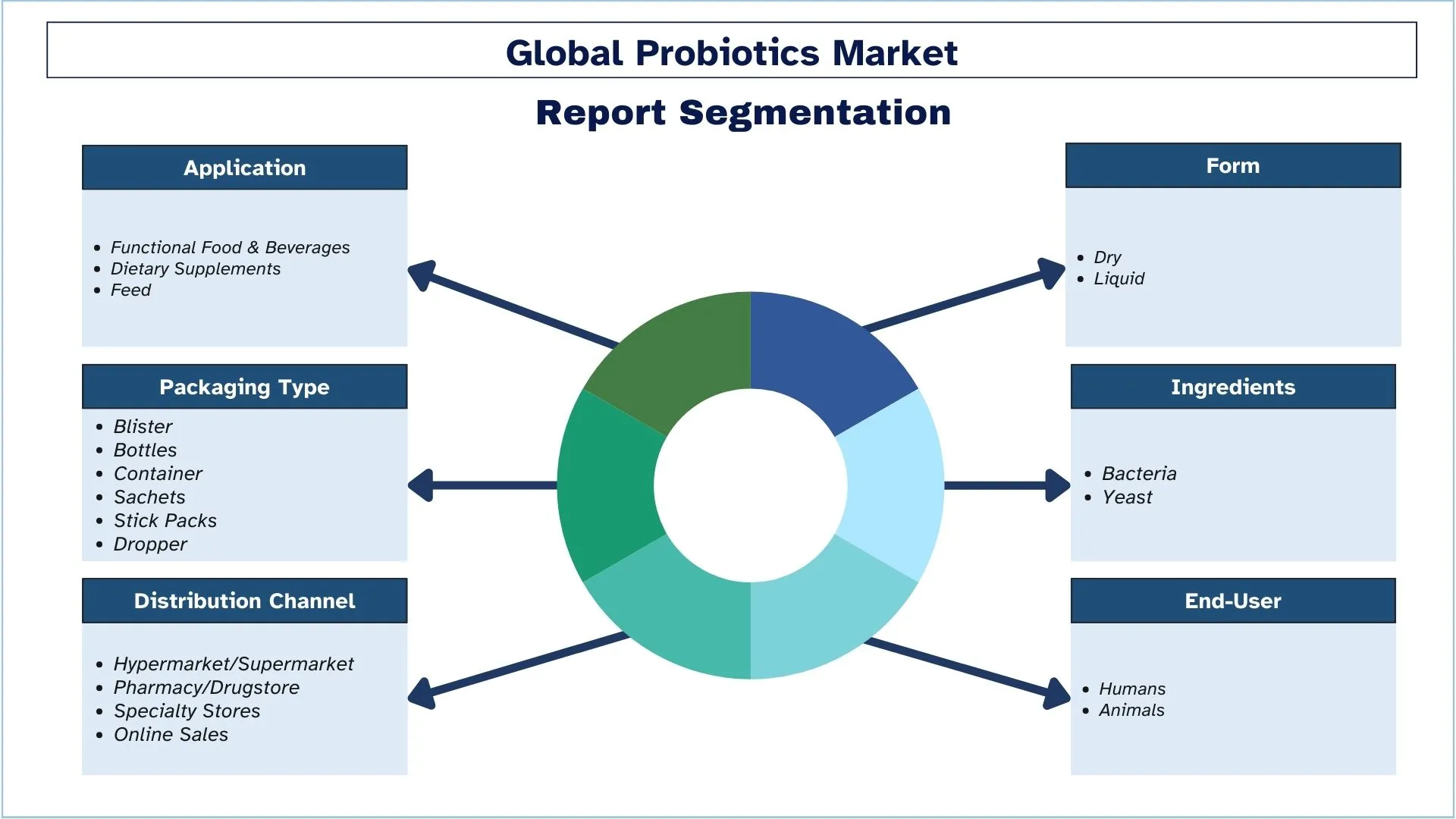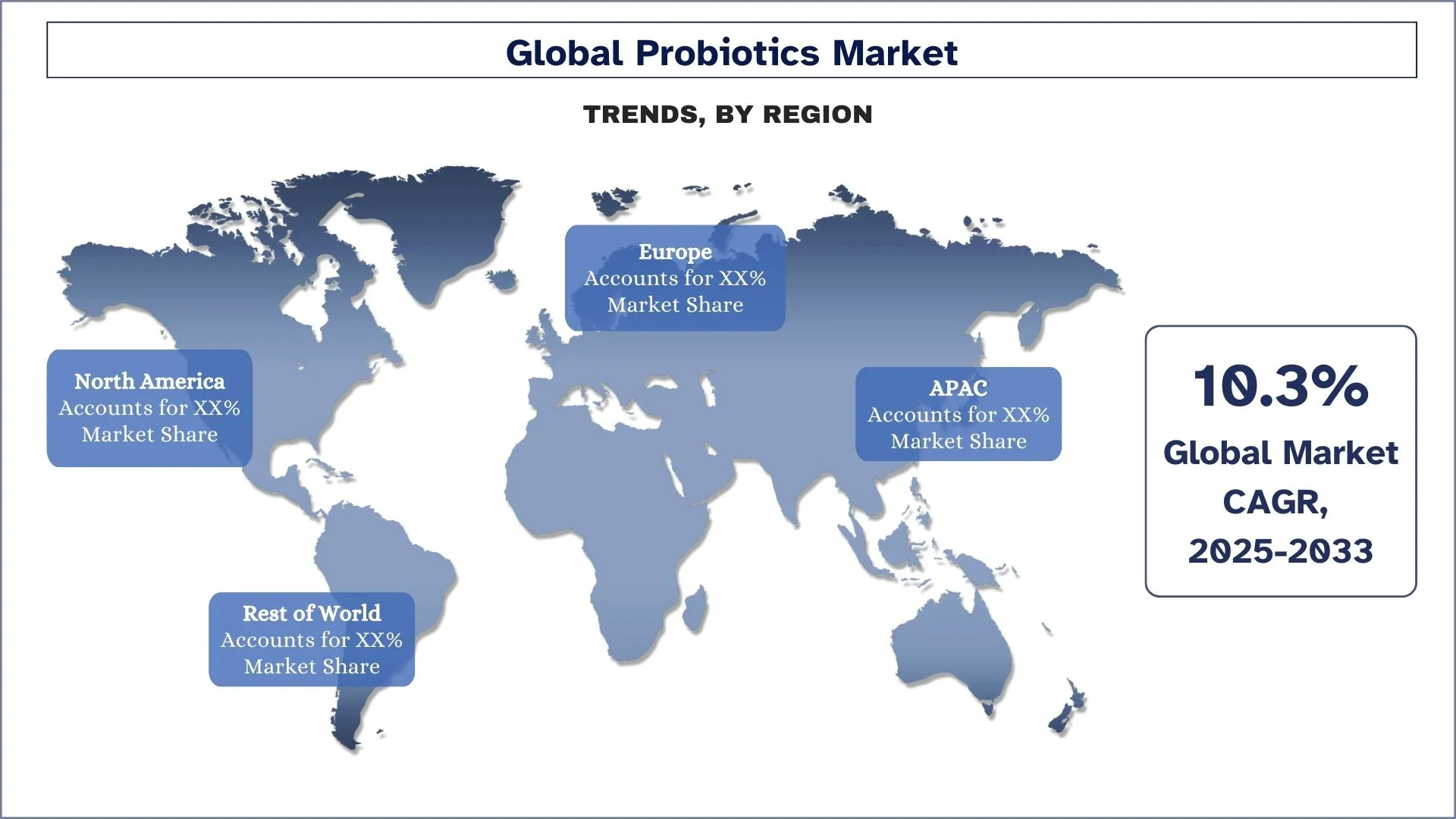
프로바이오틱스 시장 규모 및 예측
프로바이오틱스 시장은 2024년에 약 738억 달러로 평가되었으며, 예측 기간(2025-2033) 동안 약 10.3%의 상당한 연평균 성장률(CAGR)로 성장할 것으로 예상되며, 이는 프로바이오틱스 파이프라인의 증가에 기인합니다.
프로바이오틱스 시장 분석
프로바이오틱스는 장 건강 개선, 기능성 식품에 대한 수요, 예방적 의료의 증가 추세와 같은 요인에 의해 전 세계적 가능성이 촉진되고 있습니다. 오늘날의 소비자들은 소화를 돕고, 면역 체계를 강화하며, 일반적인 건강을 제공하는 천연 치료법에 더 많은 관심을 기울이고 있습니다. 요구르트 및 기타 유제품만이 수요가 있는 것은 아니며, 보충제, 음료, 심지어 스킨케어 제품까지 새롭고 독특한 제품이 출시되고 있습니다. 연구 개발 및 기술 성장에 대한 지속적인 노력이 진행되고 있으며, 이는 마이크로바이옴 건강과 새롭고 개선된 프로바이오틱스의 사용을 촉진하는 기회를 창출합니다.
프로바이오틱스 시장 동향
이 섹션에서는 연구 전문가가 파악한 프로바이오틱스 시장의 다양한 세그먼트에 영향을 미치는 주요 시장 동향에 대해 논의합니다.
장 건강을 넘어 확장
프로바이오틱스는 주로 장 건강에 사용되었지만, 이제 면역력 강화, 뇌 건강, 피부, 신진대사, 치아 건강에도 도움이 되도록 발전했습니다. 이러한 다각화는 전반적인 건강에 대한 인체 마이크로바이옴에 대한 과학적 발견이 증가했기 때문입니다. 따라서, 우리는 내부 미용, 기분 개선, 그리고 고전적인 체중 감량 부문을 포함하여 거의 모든 시장 범주에서 새로운 프로바이오틱스 제품을 볼 수 있습니다. 이러한 변화는 새로운 제품 개발에 혁명을 일으킬 뿐만 아니라 프로바이오틱스의 도움으로 기능적 웰빙에 관심 있는 소비자의 범위를 창출하거나 확장하고 있습니다.

프로바이오틱스 산업 세분화
이 섹션에서는 2025-2033년까지 글로벌, 지역 및 국가 수준의 예측과 함께 글로벌 프로바이오틱스 보고서의 각 세그먼트의 주요 트렌드를 분석합니다.
식음료 시장이 프로바이오틱스 시장에서 가장 큰 점유율을 차지합니다.
응용 분야에 따라 시장은 기능성 식품 및 음료, 식이 보충제, 사료로 세분화됩니다. 기능성 식품 및 음료 부문이 주요 시장 점유율을 차지하며 2024년 시장을 지배했습니다. 요구르트, 케피어 및 프로바이오틱스 음료를 포함한 식품 및 음료에서 소비자는 식단의 일상적인 부분으로 건강 개선을 선택하여 시장 성장을 촉진하고 있습니다. 건강하고 깨끗하며 기능적인 제품을 향한 소비자의 변화는 기업이 장 건강과 면역 체계를 지원하기 위해 프로바이오틱스 식품 제품의 길을 모색하도록 강요하고 있습니다. 이 세그먼트를 통해 제품의 침투와 접근성은 소매점을 가로질러 프로바이오틱스 시장의 성장을 이끌고 있습니다.
대형 마트/슈퍼마켓 부문이 프로바이오틱스 시장보다 더 높은 CAGR을 기록할 것으로 예상됩니다.
유통 채널에 따라 시장은 대형 마트/슈퍼마켓, 약국/드럭스토어, 전문점, 온라인 판매로 세분화됩니다. 대형 마트/슈퍼마켓 부문이 주요 시장 점유율을 차지하며 2024년 시장을 지배했습니다. 이러한 소매 형식은 비교적 다양한 청중을 보유하고 있으므로 소비자가 필요하고 맛있을 뿐만 아니라 다른 많은 필수 품목도 쉽게 구매할 수 있습니다. 지정된 프로바이오틱스의 가용성은 슈퍼마켓 및 선반의 가장 자주 방문하는 지역에 위치하여 일관성이 있으며, 끊임없이 증가하는 고객 인지도는 충동 구매에 대한 전체 시장 잠재력도 높입니다. 또한, 슈퍼마켓에서 프로바이오틱스 제품의 새로운 자체 상표가 대중에게 제공되어 시장이 더욱 확장되고 있습니다.
북미는 2024년 시장에서 상당한 점유율을 차지합니다.
북미 프로바이오틱스 시장은 소비자 인식 증가, 선진 의료 시스템, 청정 라벨 및 기능성 식품에 대한 수요 증가에 힘입어 여전히 성장하고 있습니다. 주요 기업은 주로 미국과 캐나다에서 활동하고 있으며, 스포츠 영양 및 반려동물 프로바이오틱스와 같은 제품 포트폴리오 및 새로운 세그먼트 전문화를 변경하기 위한 투자가 이루어지고 있습니다. 보다 구체적으로, 규제 조치는 인구 중 다양한 연령대와 다양한 라이프스타일에 걸쳐 CRM 시장의 인기를 더욱 향상시키고 있습니다.
미국이 북미 프로바이오틱스 시장을 지배합니다.
프로바이오틱스 시장은 건강에 관심이 많은 인구의 라이프스타일 관련 장애에 대한 천연 치료법에 대한 관심으로 인해 미국 및 전 세계적으로 서서히 성장하고 있습니다. 사업 환경의 경우, 시장은 기능성 식품 및 식이 보충제, 강화 음료가 지배하고 있습니다. 이러한 개발에는 젤리, 캡슐, 비유제품과 같은 새로운 전달 시스템 또는 다른 대규모 인구에 도달하는 다른 패턴이 포함됩니다. 또한, 과학적 증거의 증가와 의료 전문가 단체의 지지는 프로바이오틱스를 적절한 건강 및 웰빙 세그먼트로 강화합니다.

프로바이오틱스 산업 경쟁 환경
프로바이오틱스 시장은 여러 글로벌 및 국제 기업과 경쟁이 치열합니다. 주요 기업들은 파트너십, 계약, 협력, 신제품 출시, 지리적 확장 및 인수 합병과 같은 다양한 성장 전략을 채택하여 시장 입지를 강화하고 있습니다.
주요 프로바이오틱스 기업
시장에서 활동하는 주요 기업으로는 DuPont, Danone, Chr. Hansen (Novozymes), Yakult Honsha, Nestle, BioGaia AB, Probi AB (Symrise AG), Ganeden, Inc. (Kerry Group), Protexin (Archer Daniels Midland) 및 Lifeway Foods, Inc.가 있습니다.
프로바이오틱스 시장의 최근 개발
2022년 4월, 화장품 성분 생산업체인 Symrise는 보습 및 매끄러운 특성으로 스킨 케어를 향상시키도록 설계된 최첨단 성분인 SymFerment를 출시했습니다. 헬스케어 및 식품 산업용 프로바이오틱스 선도 제조업체인 Probi와 협력하여 개발된 SymFerment는 지속 가능한 화장품 기술의 중요한 발전을 나타냅니다.
2021년 7월, Symrise는 구강 관리 응용 분야를 위해 특별히 설계된 프로바이오틱 성분인 SymReboot OC를 출시했습니다. 이 혁신적인 제품은 균형 잡힌 구강 마이크로바이옴을 지원하기 위해 프로바이오틱스의 이점을 활용하여 구강 위생을 향상시키는 것을 목표로 합니다. SymReboot OC는 구강 건강과 상쾌함을 개선하는 자연스러운 솔루션을 제공하여 구강 관리 기술의 중요한 발전을 나타냅니다.
프로바이오틱스 시장 보고서 범위
세부 정보 | |
기준 연도 | 2024 |
예측 기간 | 2025-2033 |
성장 모멘텀 | 10.3%의 CAGR로 가속화 |
시장 규모 2024 | 738억 달러 |
지역 분석 | 북미, 유럽, 아시아 태평양, 기타 지역 |
주요 기여 지역 | 북미는 예측 기간 동안 가장 높은 CAGR로 성장할 것으로 예상됩니다. |
주요 국가 포함 | 미국, 캐나다, 독일, 프랑스, 영국, 스페인, 이탈리아, 중국, 일본, 인도 |
DuPont, Danone, Chr. Hansen (Novozymes), Yakult Honsha, Nestle, BioGaia AB, Probi AB (Symrise AG), Ganeden, Inc. (Kerry Group), Protexin (Archer Daniels Midland) 및 Lifeway Foods, Inc. | |
보고서 범위 | 시장 동향, 동인 및 제한 사항; 매출 추정 및 예측; 세분화 분석; 수요 및 공급 측면 분석; 경쟁 환경; 회사 프로파일링 |
포함된 세그먼트 | 어플리케이션별, 형태별, 포장 유형별, 성분별, 유통 채널별, 최종 사용자별, 지역/국가별 |
프로바이오틱스 시장 보고서 구매 이유:
본 연구는 주요 업계 전문가의 검증을 거친 시장 규모 및 예측 분석을 포함합니다.
이 보고서는 전체 산업 성과를 한눈에 빠르게 검토합니다.
이 보고서는 주요 비즈니스 재무, 제품 포트폴리오, 확장 전략 및 최근 개발 사항을 중점적으로 다루는 주요 업계 관계자에 대한 심층 분석을 제공합니다.
업계에서 우세한 동인, 제약 요인, 주요 트렌드 및 기회에 대한 상세한 검토.
본 연구는 다양한 세그먼트별 시장을 포괄적으로 다룹니다.
업계에 대한 심층적인 지역별 분석.
맞춤화 옵션:
글로벌 프로바이오틱스 시장은 요구 사항 또는 기타 시장 세그먼트에 따라 추가로 맞춤화될 수 있습니다. 이 외에도 UnivDatos는 귀사의 고유한 비즈니스 요구 사항을 이해하고 있으므로, 귀사의 요구 사항에 완벽하게 맞는 보고서를 받으시려면 언제든지 문의하십시오.
목차
프로바이오틱스 시장 분석(2023-2033) 연구 방법론
저희는 과거 시장을 분석하고, 현재 시장을 추정했으며, 전 세계 주요 지역에서의 적용을 평가하기 위해 글로벌 프로바이오틱스 시장의 미래 시장을 예측했습니다. 과거 시장 데이터를 수집하고 현재 시장 규모를 추정하기 위해 철저한 2차 조사를 실시했습니다. 이러한 통찰력을 검증하기 위해 수많은 결과와 가정을 신중하게 검토했습니다. 또한, 프로바이오틱스 가치 사슬 전반의 업계 전문가들과 심층적인 1차 인터뷰를 진행했습니다. 이러한 인터뷰를 통해 시장 수치를 검증한 후, 상향식 및 하향식 접근 방식을 사용하여 전체 시장 규모를 예측했습니다. 그 후 시장 분석 및 데이터 삼각 측량 방식을 활용하여 산업 세그먼트 및 하위 세그먼트의 시장 규모를 추정하고 분석했습니다.
시장 엔지니어링
데이터 삼각 측량 기법을 활용하여 전체 시장 추정을 최종 확정하고 글로벌 프로바이오틱스 시장의 각 세그먼트 및 하위 세그먼트에 대한 정확한 통계 수치를 도출했습니다. 어플리케이션, 형태, 포장 유형, 성분, 유통 채널, 최종 사용자 및 글로벌 프로바이오틱스 시장 내 지역을 포함한 다양한 매개변수 및 트렌드를 분석하여 데이터를 여러 세그먼트 및 하위 세그먼트로 나눴습니다.
글로벌 프로바이오틱스 시장 연구의 주요 목표는
본 연구는 글로벌 프로바이오틱스 시장의 현재 및 미래 트렌드를 파악하여 투자자를 위한 전략적 통찰력을 제공합니다. 이는 지역 시장 매력도를 강조하여 업계 참여자가 미개척 시장을 공략하고 선점 우위를 확보할 수 있도록 합니다. 연구의 다른 정량적 목표는 다음과 같습니다.
시장 규모 분석:가치(USD) 측면에서 글로벌 프로바이오틱스 시장 및 해당 세그먼트의 현재 및 예측 시장 규모를 평가합니다.
프로바이오틱스 시장 세분화:본 연구는 어플리케이션, 형태, 포장 유형, 성분, 유통 채널, 최종 사용자 및 지역별로 시장을 세분화합니다.
규제 프레임워크 및 가치 사슬 분석:프로바이오틱스 산업의 규제 프레임워크, 가치 사슬, 고객 행동 및 경쟁 환경을 검토합니다.
지역 분석:아시아 태평양, 유럽, 북미 및 기타 지역과 같은 주요 지역에 대한 상세한 지역 분석을 수행합니다.
기업 프로필 및 성장 전략:프로바이오틱스 시장의 기업 프로필 및 급성장하는 시장을 유지하기 위해 시장 선두업체가 채택한 성장 전략.
자주 묻는 질문 자주 묻는 질문
Q1: 프로바이오틱스 시장의 현재 규모와 성장 잠재력은?
글로벌 프로바이오틱스 시장은 2024년에 약 738억 달러로 평가되며 2033년까지 10.3%의 강력한 연평균 성장률(CAGR)로 성장할 것으로 예상됩니다.
Q2: 프로바이오틱스 시장 성장의 동인은 무엇인가?
장 건강과 면역력에 대한 소비자 인식이 높아짐에 따라 모든 연령대에서 프로바이오틱스 강화 식품, 음료 및 보충제에 대한 수요가 증가하고 있습니다.
Q3: 유통 채널별로 프로바이오틱스 시장에서 가장 큰 점유율을 차지하는 시장은?
대형마트/슈퍼마켓 부문이 현재 가장 큰 시장 점유율을 차지하고 있습니다.
Q4: 프로바이오틱스 시장의 주요 트렌드는 무엇인가?
시장은 개인별 프로바이오틱스와 신바이오틱스(프로바이오틱스와 프리바이오틱스의 조합)로 전환되고 있으며, 개별 미생물군 프로필을 기반으로 맞춤형 솔루션을 제공합니다.
Q5: 어떤 지역이 프로바이오틱스 시장을 지배할 것인가?
북미 지역이 현재 글로벌 프로바이오틱스 시장을 지배하고 있습니다.
Q6: 프로바이오틱스 시장의 가장 큰 과제는 무엇인가?
지역별 규제 불일치와 표준화된 라벨링의 부재는 종종 소비자 혼란을 야기하고 시장 투명성과 제품 신뢰성을 저해합니다.
Q7: 글로벌 프로바이오틱스 시장의 주요 기업은 누구인가?
프로바이오틱스 분야의 혁신을 주도하는 주요 기업은 다음과 같습니다.
• 듀폰
• 다논
• 크리스 한센 (노보자임스)
• 야쿠르트 혼샤
• 네슬레
• 바이오가이아 AB
• 프로비 AB (심라이즈 AG)
• 가네덴, Inc. (케리 그룹)
• 프로텍신 (아처 대니얼스 미들랜드)
• 라이프웨이 푸즈, Inc.
Q8: 전달 형태의 혁신이 프로바이오틱스 시장에 어떤 영향을 미치는가?
구미, 파우치, 마이크로캡슐화와 같은 전달 시스템의 발전은 소비자의 매력을 높이고 프로바이오틱스 안정성을 향상시켜 제조업체의 새로운 성장 동력을 창출하고 있습니다.
Q9: 전략적 파트너십이 프로바이오틱스 산업에서 어떤 역할을 하는가?
식품 회사, 생명 공학 회사 및 연구 기관 간의 협력은 프로바이오틱스 시장에서 제품 혁신을 가속화하고, 유통 네트워크를 확장하며, R&D 역량을 강화하고 있습니다.
관련 보고서
이 상품을 구매한 고객님들도 함께 구매하신 상품










